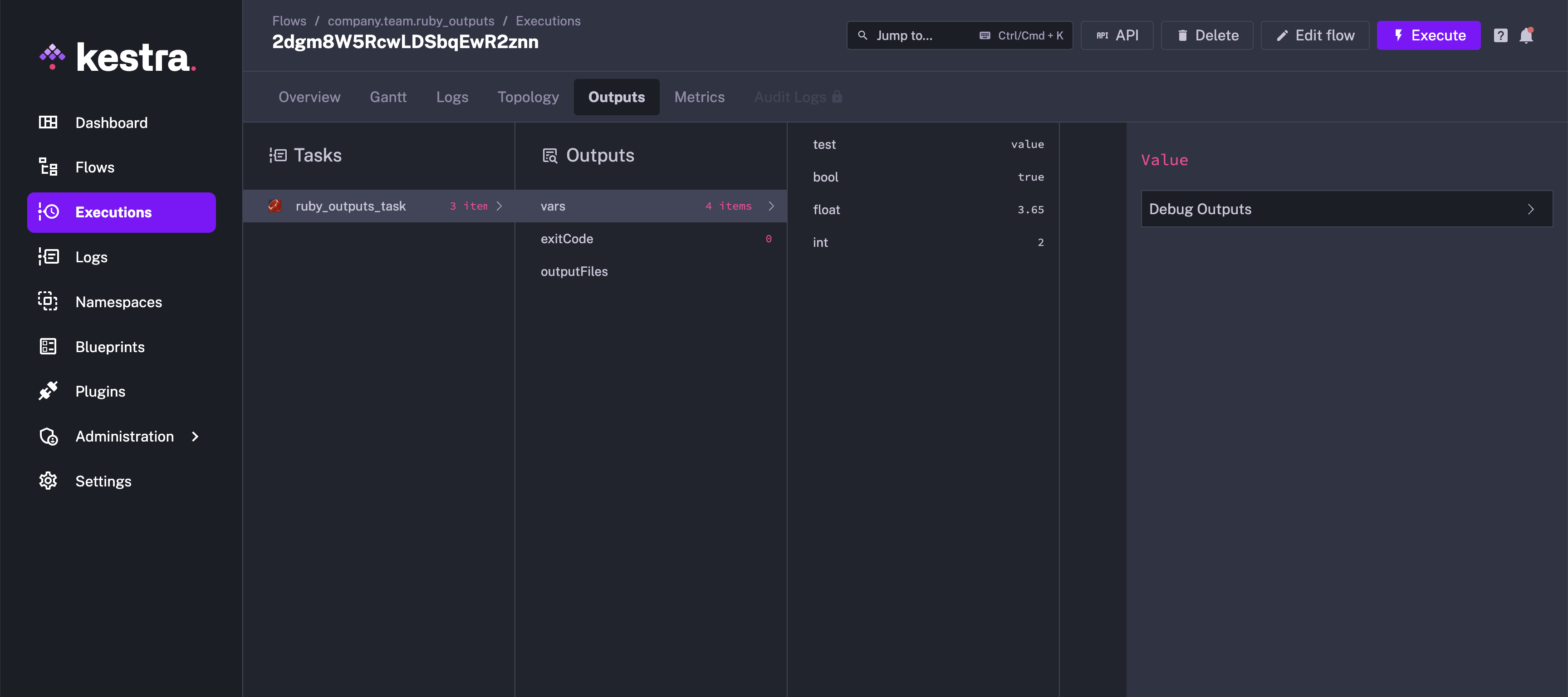 Run Ruby inside of your Flow
Run Ruby inside of your Flow
Run Ruby code directly inside of your Flows and generate outputs.
Ruby is well known for web development but has many other powerful use cases too, such as automation, web scraping, data processing and command-line tools. With Kestra, you can effortlessly automate data ingestion, as well as manage complex automations. Kestra's robust orchestration capabilities ensure that your Ruby scripts run smoothly and efficiently, streamlining your data-driven projects.
This guide is going to walk you through how to get Ruby running inside of a workflow, how to manage input and output files, and how you can pass outputs and metrics back to Kestra to use in later tasks.
Executing Rudy inside Kestra
Kestra has an official plugin for Ruby allowing you to execute R code inside of a flow by either writing your Ruby code inline or by executing an .rb file. You can get outputs and metrics from your Ruby code too.
Scripts
If you want to write a short amount of Ruby code to perform a task, you can use the io.kestra.plugin.scripts.ruby.Script type to write it directly inside of your flow. This allows you to keep everything in one place.
id: ruby_output_file
namespace: company.team
description: This flow runs the Ruby script to output a file.
tasks:
- id: ruby_outputs_task
type: io.kestra.plugin.scripts.ruby.Script
outputFiles:
- output.txt
script: |
File.open("output.txt", "w") do |file|
file.write("Hello World")
end
- id: log_output
type: io.kestra.plugin.core.log.Log
message: "{{ read(outputs.ruby_outputs_task.outputFiles['output.txt']) }}"
You can read more about the Scripts type in the Plugin documentation
Commands
If you would prefer to put your Ruby code in a .rb file (e.g. your code is much longer or spread across multiple files), you can run the previous example using the io.kestra.plugin.scripts.ruby.Commands type:
id: ruby_commands
namespace: company.team
tasks:
- id: run_ruby
type: io.kestra.plugin.scripts.ruby.Commands
namespaceFiles:
enabled: true
commands:
- ruby main.rb
The contents of the main.rb file can be:
puts "Hello World"
You'll need to add your Ruby code using the Editor or sync it using Git so Kestra can see it. You'll also need to set the enabled flag for the namespaceFiles property to true so Kestra can access the file.
You can also have the Ruby code written inline.
id: ruby_commands
namespace: company.team
tasks:
- id: http_download
type: io.kestra.plugin.core.http.Download
uri: https://huggingface.co/datasets/kestra/datasets/raw/main/csv/orders.csv
- id: run_ruby
type: io.kestra.plugin.scripts.ruby.Commands
inputFiles:
orders.csv: "{{ read(outputs.http_download.uri) }}"
main.rb: |
puts "The current execution is {{ execution.id }}"
# Read the file downloaded in `http_download` task
lines = File.readlines("orders.csv")
puts lines
commands:
- ruby main.rb
You can read more about the Commands type in the Plugin documentation.
Handling Outputs
If you want to get a variable or file from your Ruby script, you can use an output.
Variable Output
You can get the JSON outputs from the Ruby commands / script using the ::{}:: pattern. Here is an example:
id: ruby_outputs
namespace: company.team
description: This flow runs the Ruby script, and outputs the variable.
tasks:
- id: ruby_outputs_task
type: io.kestra.plugin.scripts.ruby.Script
script: |
puts '::{"outputs":{"test":"value","int":2,"bool":true,"float":3.65}}::'
All the output variables can be viewed in the Outputs tab of the execution.

You can refer to the outputs in another task as shown in the example below:
id: ruby_outputs
namespace: company.team
description: This flow runs the Ruby script, and outputs the variable.
tasks:
- id: ruby_outputs_task
type: io.kestra.plugin.scripts.ruby.Script
script: |
puts '::{"outputs":{"test":"value","int":2,"bool":true,"float":3.65}}::'
- id: return
type: io.kestra.plugin.core.debug.Return
format: '{{ outputs.ruby_outputs_task.vars.test }}'
This example works for both io.kestra.plugin.scripts.ruby.Script and io.kestra.plugin.scripts.ruby.Commands.
File Output
Inside of your Ruby script, write a file to the system. You'll need to add the outputFiles property to your flow and list the files you're trying to put out. In this case, we want to output output.txt. More information on the formats you can use for this property can be found in Script Output Metrics.
The example below writes a output.txt file containing the "Hello World" text. We can then refer the file using the syntax {{ outputs.{task_id}.outputFiles['<filename>'] }}, and read the contents of the file using the read() function.
id: ruby_output_file
namespace: company.team
description: This flow runs the Ruby script to output a file.
tasks:
- id: ruby_outputs_task
type: io.kestra.plugin.scripts.ruby.Script
outputFiles:
- output.txt
script: |
File.open("output.txt", "w") do |file|
file.write("Hello World")
end
- id: log_output
type: io.kestra.plugin.core.log.Log
message: "{{ read(outputs.ruby_outputs_task.outputFiles['output.txt']) }}"
This example works for both io.kestra.plugin.scripts.ruby.Script and io.kestra.plugin.scripts.ruby.Commands.
Handling Metrics
You can also get metrics from your Ruby script. We use the same pattern for defining metrics as we had used for outputs ::{}::. In this example, we will demonstrate both the counter and timer metrics.
id: ruby_metrics
namespace: company.team
description: This flow runs the Ruby script, and puts out the metrics.
tasks:
- id: ruby_metrics_task
type: io.kestra.plugin.scripts.ruby.Script
script: |
puts 'There are 20 products in the cart'
puts '::{"outputs":{"productCount":20}}::'
puts '::{"metrics":[{"name":"productCount","type":"counter","value":20}]}::'
puts '::{"metrics":[{"name":"purchaseTime","type":"timer","value":32.44}]}::'
Once this has executed, both the metrics can be viewed under Metrics.

Execute GraalVM Task
Kestra also supports GraalVM integration, allowing you to execute Ruby code directly on the JVM, with the potential for performance improvements. There are currently two tasks:
In this example, the Eval is used to manipulate data from a previous task. GraalVM makes it easy to generate outputs from variables in Python using the outputs property. This is useful if you want to manipulate data and pass the new format to another task.
id: parse_json_data
namespace: company.team
tasks:
- id: download
type: io.kestra.plugin.core.http.Download
uri: http://xkcd.com/info.0.json
- id: graal
type: io.kestra.plugin.graalvm.ruby.Eval
outputs:
- data
script: |
data = {{ read(outputs.download.uri) }}
data["next_month"] = '{{ read(outputs.download.uri) | jq(".month") | first }}'.to_i + 1
return {data: data}
Was this page helpful?